Knowledge of Disaster Preparedness Management by Nurses in Saudi
VerifiedAdded on 2023/04/21
|40
|12059
|452
Report
AI Summary
This report assesses the knowledge, awareness, and skills of emergency nurses in Mecca, Saudi Arabia, regarding disaster preparedness during the Hajj mass gathering. The cross-sectional survey, conducted at the Emergency Department of Security Forces Hospital Makkah, involved 96 registered emergency nurses. The study reveals variable knowledge and awareness of disaster management among participants, highlighting significant deficits. Emergency nurses showed a preference for acute clinical tasks over proactive measures like surveillance and prevention, with less emphasis on leadership and psychological care. While demonstrating a good understanding of their role in mass gathering management, the study concludes that hospital management and the Ministry of Health should encourage and support emergency nurses to improve their involvement in disaster situations. The research underscores the necessity of disaster preparedness training for nursing professionals, considering the complex challenges arising from emergency incidents in Saudi Arabia.
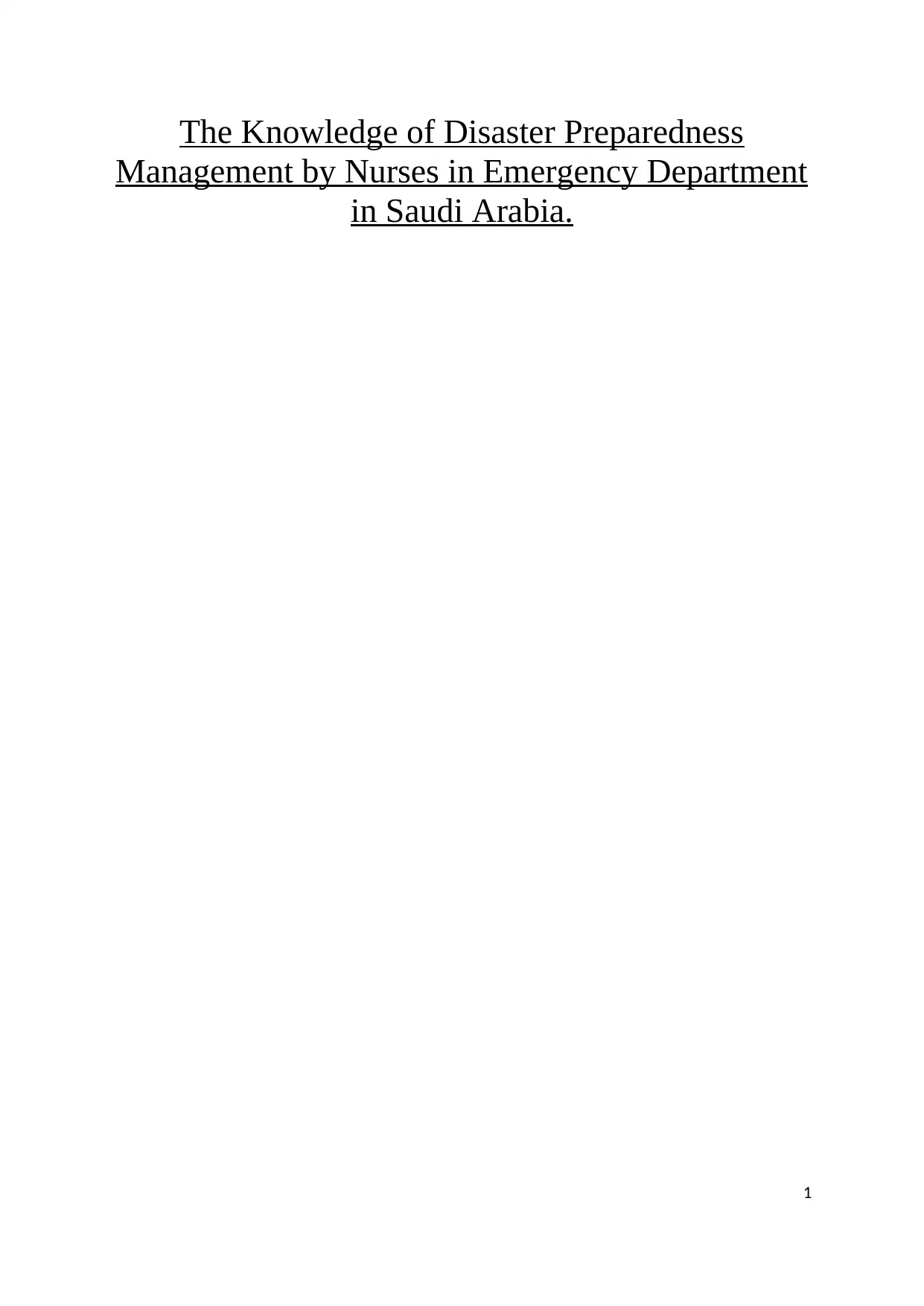
The Knowledge of Disaster Preparedness
Management by Nurses in Emergency Department
in Saudi Arabia.
1
Management by Nurses in Emergency Department
in Saudi Arabia.
1
Paraphrase This Document
Need a fresh take? Get an instant paraphrase of this document with our AI Paraphraser
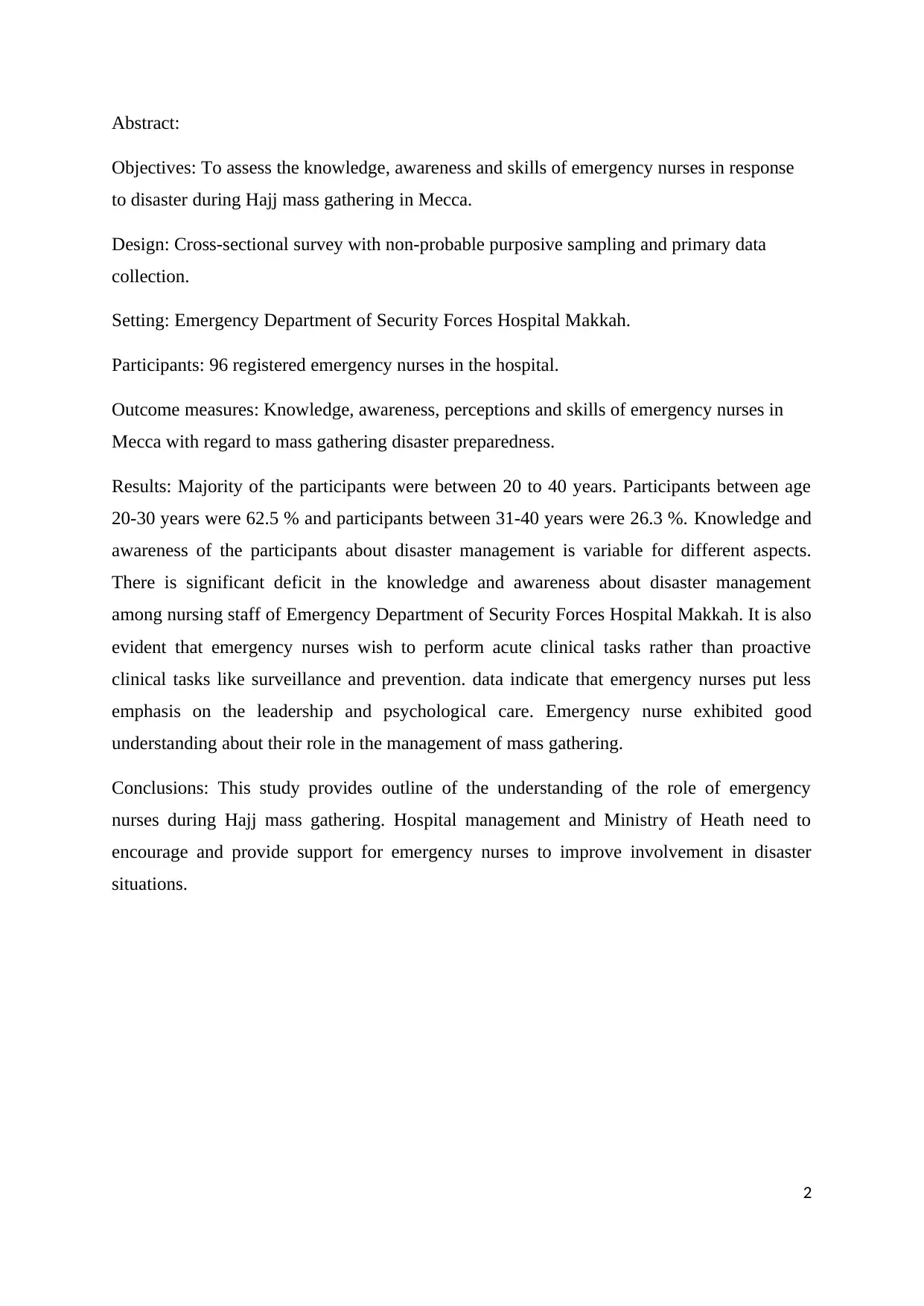
Abstract:
Objectives: To assess the knowledge, awareness and skills of emergency nurses in response
to disaster during Hajj mass gathering in Mecca.
Design: Cross-sectional survey with non-probable purposive sampling and primary data
collection.
Setting: Emergency Department of Security Forces Hospital Makkah.
Participants: 96 registered emergency nurses in the hospital.
Outcome measures: Knowledge, awareness, perceptions and skills of emergency nurses in
Mecca with regard to mass gathering disaster preparedness.
Results: Majority of the participants were between 20 to 40 years. Participants between age
20-30 years were 62.5 % and participants between 31-40 years were 26.3 %. Knowledge and
awareness of the participants about disaster management is variable for different aspects.
There is significant deficit in the knowledge and awareness about disaster management
among nursing staff of Emergency Department of Security Forces Hospital Makkah. It is also
evident that emergency nurses wish to perform acute clinical tasks rather than proactive
clinical tasks like surveillance and prevention. data indicate that emergency nurses put less
emphasis on the leadership and psychological care. Emergency nurse exhibited good
understanding about their role in the management of mass gathering.
Conclusions: This study provides outline of the understanding of the role of emergency
nurses during Hajj mass gathering. Hospital management and Ministry of Heath need to
encourage and provide support for emergency nurses to improve involvement in disaster
situations.
2
Objectives: To assess the knowledge, awareness and skills of emergency nurses in response
to disaster during Hajj mass gathering in Mecca.
Design: Cross-sectional survey with non-probable purposive sampling and primary data
collection.
Setting: Emergency Department of Security Forces Hospital Makkah.
Participants: 96 registered emergency nurses in the hospital.
Outcome measures: Knowledge, awareness, perceptions and skills of emergency nurses in
Mecca with regard to mass gathering disaster preparedness.
Results: Majority of the participants were between 20 to 40 years. Participants between age
20-30 years were 62.5 % and participants between 31-40 years were 26.3 %. Knowledge and
awareness of the participants about disaster management is variable for different aspects.
There is significant deficit in the knowledge and awareness about disaster management
among nursing staff of Emergency Department of Security Forces Hospital Makkah. It is also
evident that emergency nurses wish to perform acute clinical tasks rather than proactive
clinical tasks like surveillance and prevention. data indicate that emergency nurses put less
emphasis on the leadership and psychological care. Emergency nurse exhibited good
understanding about their role in the management of mass gathering.
Conclusions: This study provides outline of the understanding of the role of emergency
nurses during Hajj mass gathering. Hospital management and Ministry of Heath need to
encourage and provide support for emergency nurses to improve involvement in disaster
situations.
2
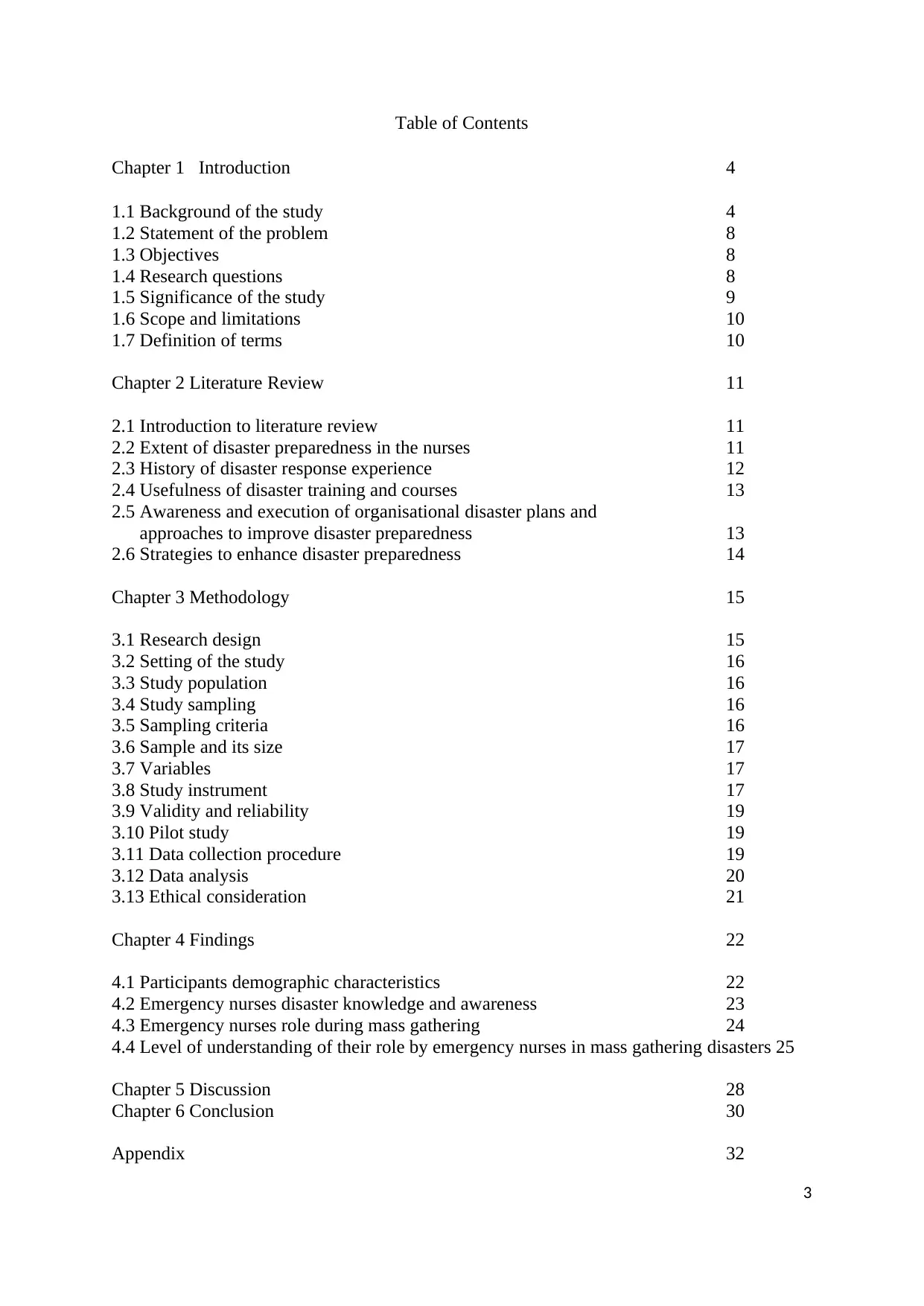
Table of Contents
Chapter 1 Introduction 4
1.1 Background of the study 4
1.2 Statement of the problem 8
1.3 Objectives 8
1.4 Research questions 8
1.5 Significance of the study 9
1.6 Scope and limitations 10
1.7 Definition of terms 10
Chapter 2 Literature Review 11
2.1 Introduction to literature review 11
2.2 Extent of disaster preparedness in the nurses 11
2.3 History of disaster response experience 12
2.4 Usefulness of disaster training and courses 13
2.5 Awareness and execution of organisational disaster plans and
approaches to improve disaster preparedness 13
2.6 Strategies to enhance disaster preparedness 14
Chapter 3 Methodology 15
3.1 Research design 15
3.2 Setting of the study 16
3.3 Study population 16
3.4 Study sampling 16
3.5 Sampling criteria 16
3.6 Sample and its size 17
3.7 Variables 17
3.8 Study instrument 17
3.9 Validity and reliability 19
3.10 Pilot study 19
3.11 Data collection procedure 19
3.12 Data analysis 20
3.13 Ethical consideration 21
Chapter 4 Findings 22
4.1 Participants demographic characteristics 22
4.2 Emergency nurses disaster knowledge and awareness 23
4.3 Emergency nurses role during mass gathering 24
4.4 Level of understanding of their role by emergency nurses in mass gathering disasters 25
Chapter 5 Discussion 28
Chapter 6 Conclusion 30
Appendix 32
3
Chapter 1 Introduction 4
1.1 Background of the study 4
1.2 Statement of the problem 8
1.3 Objectives 8
1.4 Research questions 8
1.5 Significance of the study 9
1.6 Scope and limitations 10
1.7 Definition of terms 10
Chapter 2 Literature Review 11
2.1 Introduction to literature review 11
2.2 Extent of disaster preparedness in the nurses 11
2.3 History of disaster response experience 12
2.4 Usefulness of disaster training and courses 13
2.5 Awareness and execution of organisational disaster plans and
approaches to improve disaster preparedness 13
2.6 Strategies to enhance disaster preparedness 14
Chapter 3 Methodology 15
3.1 Research design 15
3.2 Setting of the study 16
3.3 Study population 16
3.4 Study sampling 16
3.5 Sampling criteria 16
3.6 Sample and its size 17
3.7 Variables 17
3.8 Study instrument 17
3.9 Validity and reliability 19
3.10 Pilot study 19
3.11 Data collection procedure 19
3.12 Data analysis 20
3.13 Ethical consideration 21
Chapter 4 Findings 22
4.1 Participants demographic characteristics 22
4.2 Emergency nurses disaster knowledge and awareness 23
4.3 Emergency nurses role during mass gathering 24
4.4 Level of understanding of their role by emergency nurses in mass gathering disasters 25
Chapter 5 Discussion 28
Chapter 6 Conclusion 30
Appendix 32
3
⊘ This is a preview!⊘
Do you want full access?
Subscribe today to unlock all pages.

Trusted by 1+ million students worldwide
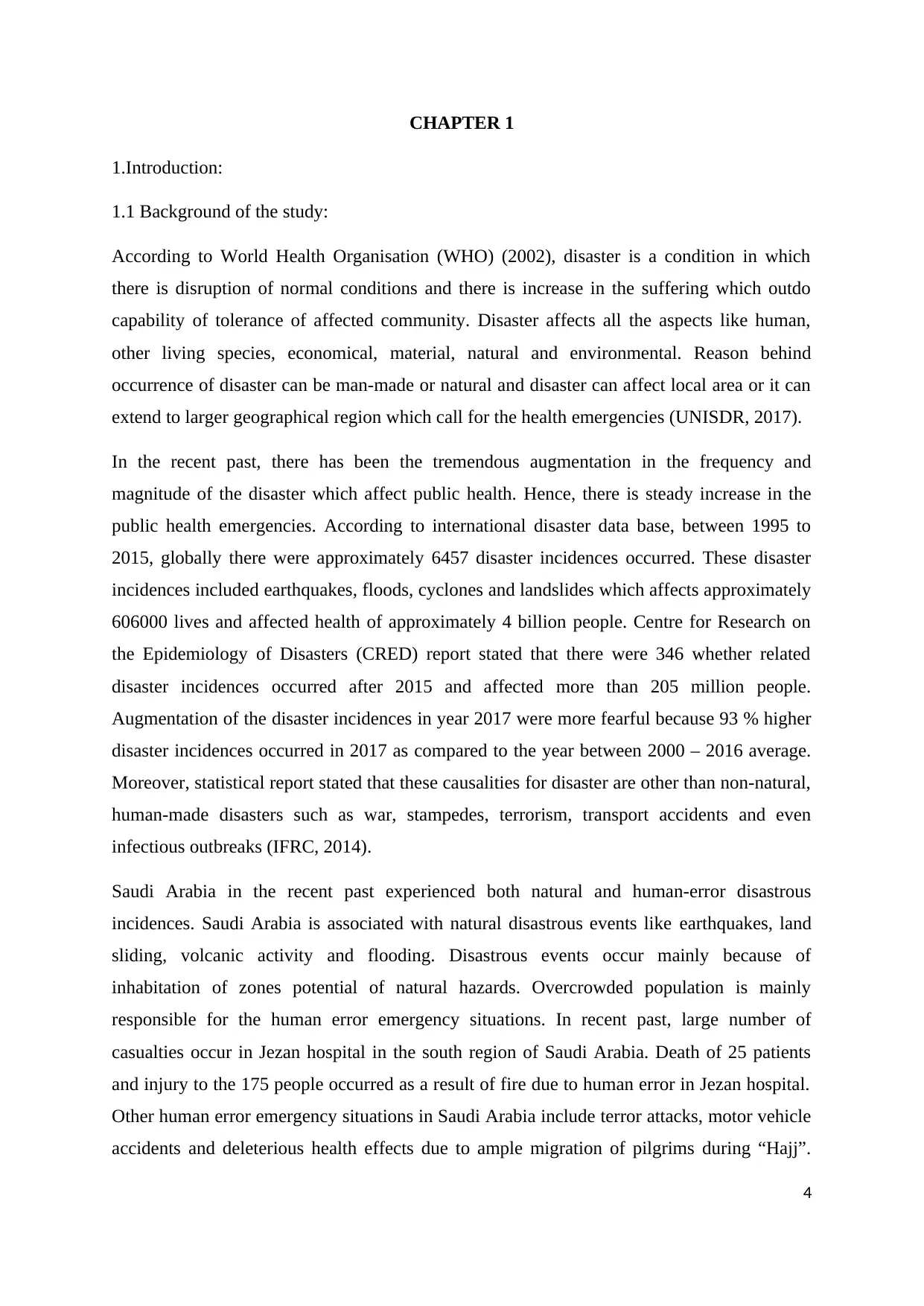
CHAPTER 1
1.Introduction:
1.1 Background of the study:
According to World Health Organisation (WHO) (2002), disaster is a condition in which
there is disruption of normal conditions and there is increase in the suffering which outdo
capability of tolerance of affected community. Disaster affects all the aspects like human,
other living species, economical, material, natural and environmental. Reason behind
occurrence of disaster can be man-made or natural and disaster can affect local area or it can
extend to larger geographical region which call for the health emergencies (UNISDR, 2017).
In the recent past, there has been the tremendous augmentation in the frequency and
magnitude of the disaster which affect public health. Hence, there is steady increase in the
public health emergencies. According to international disaster data base, between 1995 to
2015, globally there were approximately 6457 disaster incidences occurred. These disaster
incidences included earthquakes, floods, cyclones and landslides which affects approximately
606000 lives and affected health of approximately 4 billion people. Centre for Research on
the Epidemiology of Disasters (CRED) report stated that there were 346 whether related
disaster incidences occurred after 2015 and affected more than 205 million people.
Augmentation of the disaster incidences in year 2017 were more fearful because 93 % higher
disaster incidences occurred in 2017 as compared to the year between 2000 – 2016 average.
Moreover, statistical report stated that these causalities for disaster are other than non-natural,
human-made disasters such as war, stampedes, terrorism, transport accidents and even
infectious outbreaks (IFRC, 2014).
Saudi Arabia in the recent past experienced both natural and human-error disastrous
incidences. Saudi Arabia is associated with natural disastrous events like earthquakes, land
sliding, volcanic activity and flooding. Disastrous events occur mainly because of
inhabitation of zones potential of natural hazards. Overcrowded population is mainly
responsible for the human error emergency situations. In recent past, large number of
casualties occur in Jezan hospital in the south region of Saudi Arabia. Death of 25 patients
and injury to the 175 people occurred as a result of fire due to human error in Jezan hospital.
Other human error emergency situations in Saudi Arabia include terror attacks, motor vehicle
accidents and deleterious health effects due to ample migration of pilgrims during “Hajj”.
4
1.Introduction:
1.1 Background of the study:
According to World Health Organisation (WHO) (2002), disaster is a condition in which
there is disruption of normal conditions and there is increase in the suffering which outdo
capability of tolerance of affected community. Disaster affects all the aspects like human,
other living species, economical, material, natural and environmental. Reason behind
occurrence of disaster can be man-made or natural and disaster can affect local area or it can
extend to larger geographical region which call for the health emergencies (UNISDR, 2017).
In the recent past, there has been the tremendous augmentation in the frequency and
magnitude of the disaster which affect public health. Hence, there is steady increase in the
public health emergencies. According to international disaster data base, between 1995 to
2015, globally there were approximately 6457 disaster incidences occurred. These disaster
incidences included earthquakes, floods, cyclones and landslides which affects approximately
606000 lives and affected health of approximately 4 billion people. Centre for Research on
the Epidemiology of Disasters (CRED) report stated that there were 346 whether related
disaster incidences occurred after 2015 and affected more than 205 million people.
Augmentation of the disaster incidences in year 2017 were more fearful because 93 % higher
disaster incidences occurred in 2017 as compared to the year between 2000 – 2016 average.
Moreover, statistical report stated that these causalities for disaster are other than non-natural,
human-made disasters such as war, stampedes, terrorism, transport accidents and even
infectious outbreaks (IFRC, 2014).
Saudi Arabia in the recent past experienced both natural and human-error disastrous
incidences. Saudi Arabia is associated with natural disastrous events like earthquakes, land
sliding, volcanic activity and flooding. Disastrous events occur mainly because of
inhabitation of zones potential of natural hazards. Overcrowded population is mainly
responsible for the human error emergency situations. In recent past, large number of
casualties occur in Jezan hospital in the south region of Saudi Arabia. Death of 25 patients
and injury to the 175 people occurred as a result of fire due to human error in Jezan hospital.
Other human error emergency situations in Saudi Arabia include terror attacks, motor vehicle
accidents and deleterious health effects due to ample migration of pilgrims during “Hajj”.
4
Paraphrase This Document
Need a fresh take? Get an instant paraphrase of this document with our AI Paraphraser
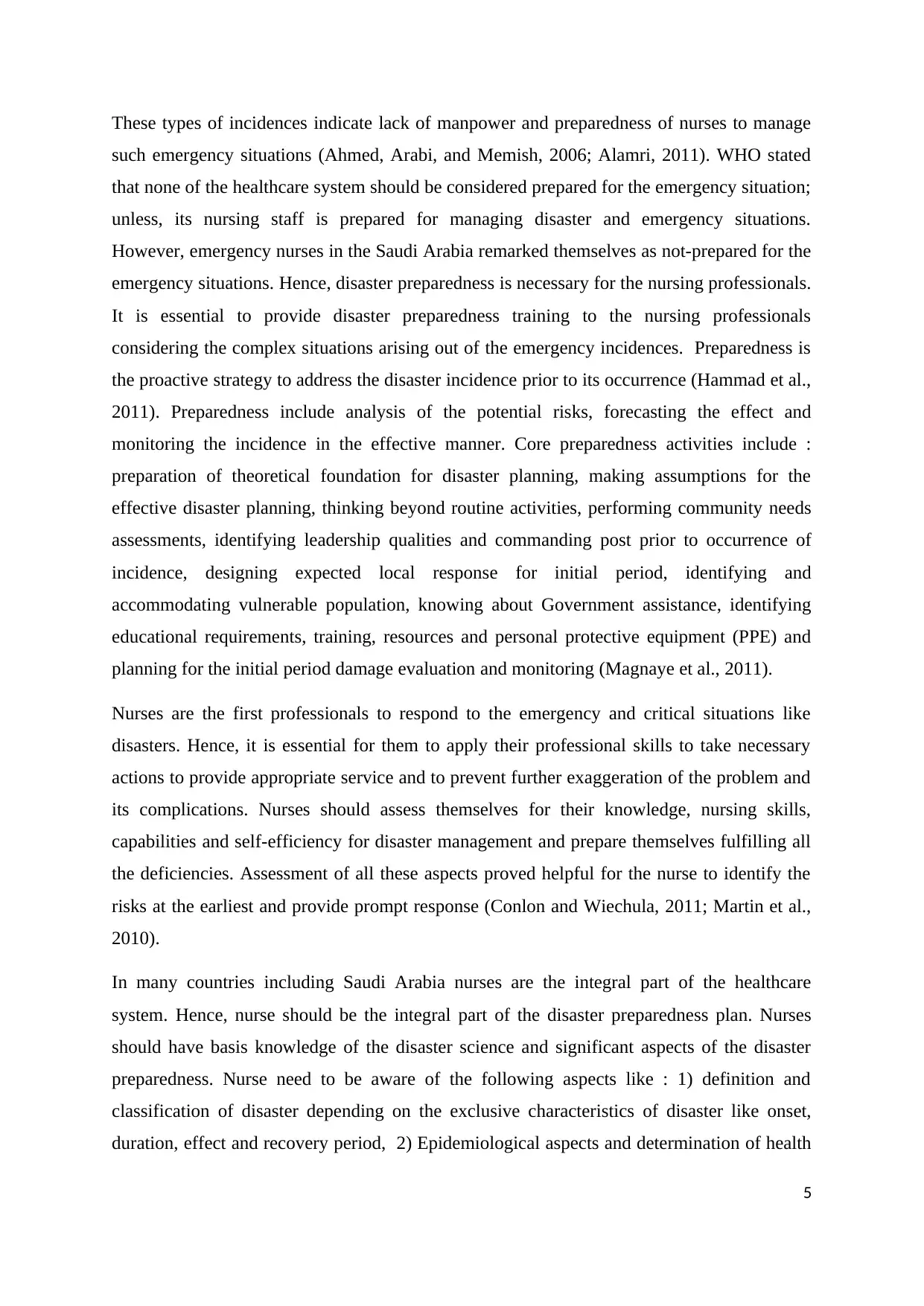
These types of incidences indicate lack of manpower and preparedness of nurses to manage
such emergency situations (Ahmed, Arabi, and Memish, 2006; Alamri, 2011). WHO stated
that none of the healthcare system should be considered prepared for the emergency situation;
unless, its nursing staff is prepared for managing disaster and emergency situations.
However, emergency nurses in the Saudi Arabia remarked themselves as not-prepared for the
emergency situations. Hence, disaster preparedness is necessary for the nursing professionals.
It is essential to provide disaster preparedness training to the nursing professionals
considering the complex situations arising out of the emergency incidences. Preparedness is
the proactive strategy to address the disaster incidence prior to its occurrence (Hammad et al.,
2011). Preparedness include analysis of the potential risks, forecasting the effect and
monitoring the incidence in the effective manner. Core preparedness activities include :
preparation of theoretical foundation for disaster planning, making assumptions for the
effective disaster planning, thinking beyond routine activities, performing community needs
assessments, identifying leadership qualities and commanding post prior to occurrence of
incidence, designing expected local response for initial period, identifying and
accommodating vulnerable population, knowing about Government assistance, identifying
educational requirements, training, resources and personal protective equipment (PPE) and
planning for the initial period damage evaluation and monitoring (Magnaye et al., 2011).
Nurses are the first professionals to respond to the emergency and critical situations like
disasters. Hence, it is essential for them to apply their professional skills to take necessary
actions to provide appropriate service and to prevent further exaggeration of the problem and
its complications. Nurses should assess themselves for their knowledge, nursing skills,
capabilities and self-efficiency for disaster management and prepare themselves fulfilling all
the deficiencies. Assessment of all these aspects proved helpful for the nurse to identify the
risks at the earliest and provide prompt response (Conlon and Wiechula, 2011; Martin et al.,
2010).
In many countries including Saudi Arabia nurses are the integral part of the healthcare
system. Hence, nurse should be the integral part of the disaster preparedness plan. Nurses
should have basis knowledge of the disaster science and significant aspects of the disaster
preparedness. Nurse need to be aware of the following aspects like : 1) definition and
classification of disaster depending on the exclusive characteristics of disaster like onset,
duration, effect and recovery period, 2) Epidemiological aspects and determination of health
5
such emergency situations (Ahmed, Arabi, and Memish, 2006; Alamri, 2011). WHO stated
that none of the healthcare system should be considered prepared for the emergency situation;
unless, its nursing staff is prepared for managing disaster and emergency situations.
However, emergency nurses in the Saudi Arabia remarked themselves as not-prepared for the
emergency situations. Hence, disaster preparedness is necessary for the nursing professionals.
It is essential to provide disaster preparedness training to the nursing professionals
considering the complex situations arising out of the emergency incidences. Preparedness is
the proactive strategy to address the disaster incidence prior to its occurrence (Hammad et al.,
2011). Preparedness include analysis of the potential risks, forecasting the effect and
monitoring the incidence in the effective manner. Core preparedness activities include :
preparation of theoretical foundation for disaster planning, making assumptions for the
effective disaster planning, thinking beyond routine activities, performing community needs
assessments, identifying leadership qualities and commanding post prior to occurrence of
incidence, designing expected local response for initial period, identifying and
accommodating vulnerable population, knowing about Government assistance, identifying
educational requirements, training, resources and personal protective equipment (PPE) and
planning for the initial period damage evaluation and monitoring (Magnaye et al., 2011).
Nurses are the first professionals to respond to the emergency and critical situations like
disasters. Hence, it is essential for them to apply their professional skills to take necessary
actions to provide appropriate service and to prevent further exaggeration of the problem and
its complications. Nurses should assess themselves for their knowledge, nursing skills,
capabilities and self-efficiency for disaster management and prepare themselves fulfilling all
the deficiencies. Assessment of all these aspects proved helpful for the nurse to identify the
risks at the earliest and provide prompt response (Conlon and Wiechula, 2011; Martin et al.,
2010).
In many countries including Saudi Arabia nurses are the integral part of the healthcare
system. Hence, nurse should be the integral part of the disaster preparedness plan. Nurses
should have basis knowledge of the disaster science and significant aspects of the disaster
preparedness. Nurse need to be aware of the following aspects like : 1) definition and
classification of disaster depending on the exclusive characteristics of disaster like onset,
duration, effect and recovery period, 2) Epidemiological aspects and determination of health
5
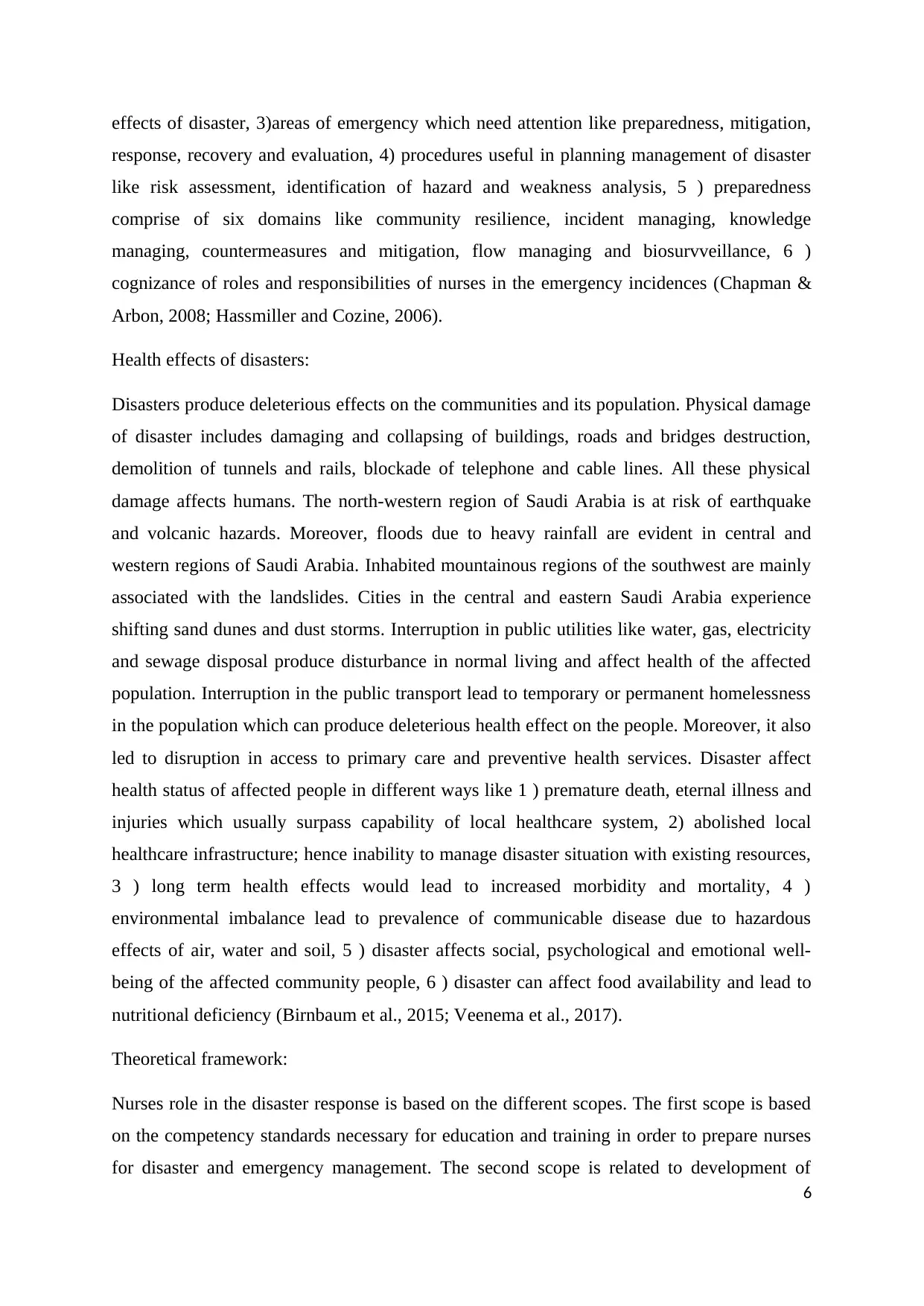
effects of disaster, 3)areas of emergency which need attention like preparedness, mitigation,
response, recovery and evaluation, 4) procedures useful in planning management of disaster
like risk assessment, identification of hazard and weakness analysis, 5 ) preparedness
comprise of six domains like community resilience, incident managing, knowledge
managing, countermeasures and mitigation, flow managing and biosurvveillance, 6 )
cognizance of roles and responsibilities of nurses in the emergency incidences (Chapman &
Arbon, 2008; Hassmiller and Cozine, 2006).
Health effects of disasters:
Disasters produce deleterious effects on the communities and its population. Physical damage
of disaster includes damaging and collapsing of buildings, roads and bridges destruction,
demolition of tunnels and rails, blockade of telephone and cable lines. All these physical
damage affects humans. The north-western region of Saudi Arabia is at risk of earthquake
and volcanic hazards. Moreover, floods due to heavy rainfall are evident in central and
western regions of Saudi Arabia. Inhabited mountainous regions of the southwest are mainly
associated with the landslides. Cities in the central and eastern Saudi Arabia experience
shifting sand dunes and dust storms. Interruption in public utilities like water, gas, electricity
and sewage disposal produce disturbance in normal living and affect health of the affected
population. Interruption in the public transport lead to temporary or permanent homelessness
in the population which can produce deleterious health effect on the people. Moreover, it also
led to disruption in access to primary care and preventive health services. Disaster affect
health status of affected people in different ways like 1 ) premature death, eternal illness and
injuries which usually surpass capability of local healthcare system, 2) abolished local
healthcare infrastructure; hence inability to manage disaster situation with existing resources,
3 ) long term health effects would lead to increased morbidity and mortality, 4 )
environmental imbalance lead to prevalence of communicable disease due to hazardous
effects of air, water and soil, 5 ) disaster affects social, psychological and emotional well-
being of the affected community people, 6 ) disaster can affect food availability and lead to
nutritional deficiency (Birnbaum et al., 2015; Veenema et al., 2017).
Theoretical framework:
Nurses role in the disaster response is based on the different scopes. The first scope is based
on the competency standards necessary for education and training in order to prepare nurses
for disaster and emergency management. The second scope is related to development of
6
response, recovery and evaluation, 4) procedures useful in planning management of disaster
like risk assessment, identification of hazard and weakness analysis, 5 ) preparedness
comprise of six domains like community resilience, incident managing, knowledge
managing, countermeasures and mitigation, flow managing and biosurvveillance, 6 )
cognizance of roles and responsibilities of nurses in the emergency incidences (Chapman &
Arbon, 2008; Hassmiller and Cozine, 2006).
Health effects of disasters:
Disasters produce deleterious effects on the communities and its population. Physical damage
of disaster includes damaging and collapsing of buildings, roads and bridges destruction,
demolition of tunnels and rails, blockade of telephone and cable lines. All these physical
damage affects humans. The north-western region of Saudi Arabia is at risk of earthquake
and volcanic hazards. Moreover, floods due to heavy rainfall are evident in central and
western regions of Saudi Arabia. Inhabited mountainous regions of the southwest are mainly
associated with the landslides. Cities in the central and eastern Saudi Arabia experience
shifting sand dunes and dust storms. Interruption in public utilities like water, gas, electricity
and sewage disposal produce disturbance in normal living and affect health of the affected
population. Interruption in the public transport lead to temporary or permanent homelessness
in the population which can produce deleterious health effect on the people. Moreover, it also
led to disruption in access to primary care and preventive health services. Disaster affect
health status of affected people in different ways like 1 ) premature death, eternal illness and
injuries which usually surpass capability of local healthcare system, 2) abolished local
healthcare infrastructure; hence inability to manage disaster situation with existing resources,
3 ) long term health effects would lead to increased morbidity and mortality, 4 )
environmental imbalance lead to prevalence of communicable disease due to hazardous
effects of air, water and soil, 5 ) disaster affects social, psychological and emotional well-
being of the affected community people, 6 ) disaster can affect food availability and lead to
nutritional deficiency (Birnbaum et al., 2015; Veenema et al., 2017).
Theoretical framework:
Nurses role in the disaster response is based on the different scopes. The first scope is based
on the competency standards necessary for education and training in order to prepare nurses
for disaster and emergency management. The second scope is related to development of
6
⊘ This is a preview!⊘
Do you want full access?
Subscribe today to unlock all pages.

Trusted by 1+ million students worldwide
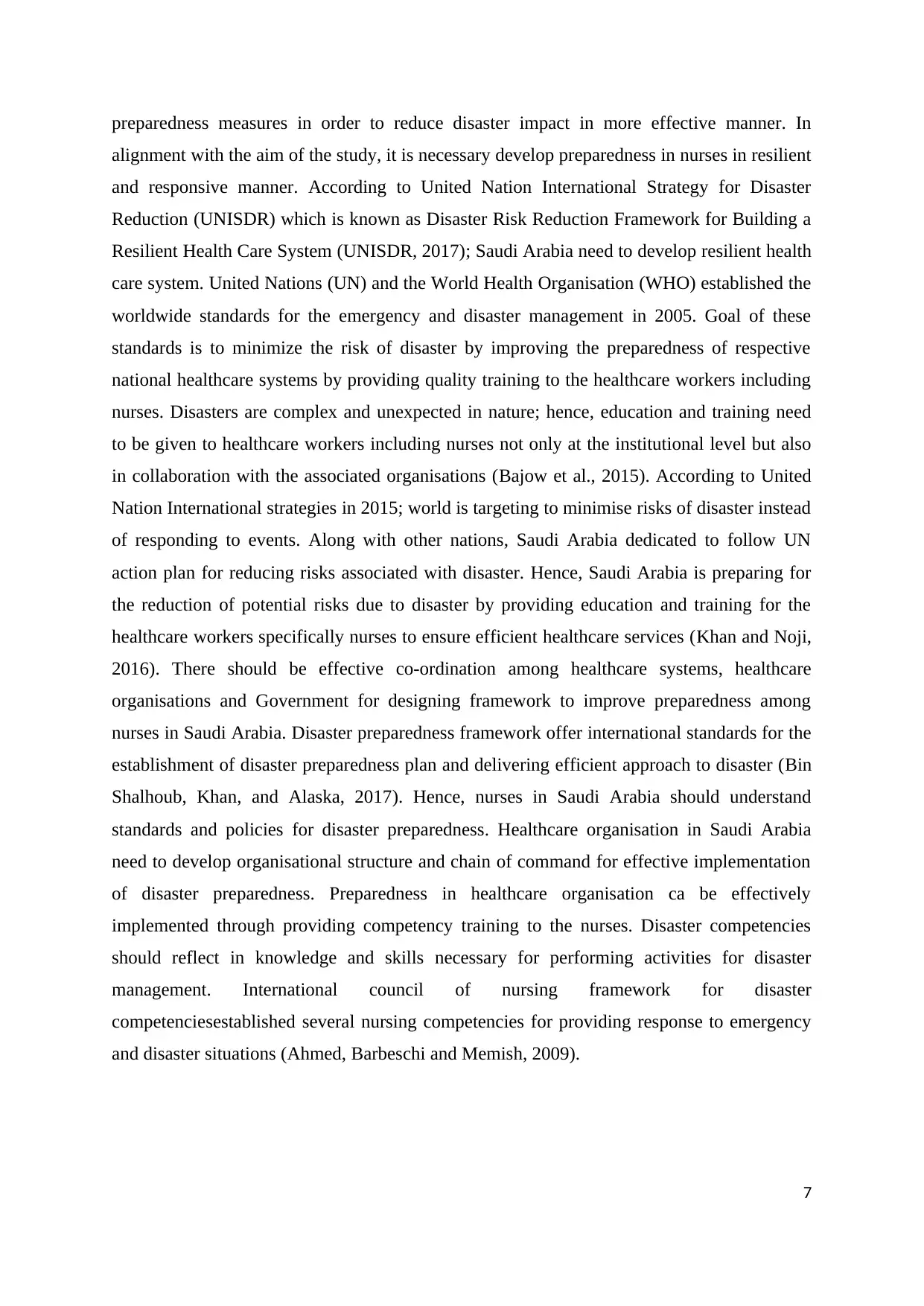
preparedness measures in order to reduce disaster impact in more effective manner. In
alignment with the aim of the study, it is necessary develop preparedness in nurses in resilient
and responsive manner. According to United Nation International Strategy for Disaster
Reduction (UNISDR) which is known as Disaster Risk Reduction Framework for Building a
Resilient Health Care System (UNISDR, 2017); Saudi Arabia need to develop resilient health
care system. United Nations (UN) and the World Health Organisation (WHO) established the
worldwide standards for the emergency and disaster management in 2005. Goal of these
standards is to minimize the risk of disaster by improving the preparedness of respective
national healthcare systems by providing quality training to the healthcare workers including
nurses. Disasters are complex and unexpected in nature; hence, education and training need
to be given to healthcare workers including nurses not only at the institutional level but also
in collaboration with the associated organisations (Bajow et al., 2015). According to United
Nation International strategies in 2015; world is targeting to minimise risks of disaster instead
of responding to events. Along with other nations, Saudi Arabia dedicated to follow UN
action plan for reducing risks associated with disaster. Hence, Saudi Arabia is preparing for
the reduction of potential risks due to disaster by providing education and training for the
healthcare workers specifically nurses to ensure efficient healthcare services (Khan and Noji,
2016). There should be effective co-ordination among healthcare systems, healthcare
organisations and Government for designing framework to improve preparedness among
nurses in Saudi Arabia. Disaster preparedness framework offer international standards for the
establishment of disaster preparedness plan and delivering efficient approach to disaster (Bin
Shalhoub, Khan, and Alaska, 2017). Hence, nurses in Saudi Arabia should understand
standards and policies for disaster preparedness. Healthcare organisation in Saudi Arabia
need to develop organisational structure and chain of command for effective implementation
of disaster preparedness. Preparedness in healthcare organisation ca be effectively
implemented through providing competency training to the nurses. Disaster competencies
should reflect in knowledge and skills necessary for performing activities for disaster
management. International council of nursing framework for disaster
competenciesestablished several nursing competencies for providing response to emergency
and disaster situations (Ahmed, Barbeschi and Memish, 2009).
7
alignment with the aim of the study, it is necessary develop preparedness in nurses in resilient
and responsive manner. According to United Nation International Strategy for Disaster
Reduction (UNISDR) which is known as Disaster Risk Reduction Framework for Building a
Resilient Health Care System (UNISDR, 2017); Saudi Arabia need to develop resilient health
care system. United Nations (UN) and the World Health Organisation (WHO) established the
worldwide standards for the emergency and disaster management in 2005. Goal of these
standards is to minimize the risk of disaster by improving the preparedness of respective
national healthcare systems by providing quality training to the healthcare workers including
nurses. Disasters are complex and unexpected in nature; hence, education and training need
to be given to healthcare workers including nurses not only at the institutional level but also
in collaboration with the associated organisations (Bajow et al., 2015). According to United
Nation International strategies in 2015; world is targeting to minimise risks of disaster instead
of responding to events. Along with other nations, Saudi Arabia dedicated to follow UN
action plan for reducing risks associated with disaster. Hence, Saudi Arabia is preparing for
the reduction of potential risks due to disaster by providing education and training for the
healthcare workers specifically nurses to ensure efficient healthcare services (Khan and Noji,
2016). There should be effective co-ordination among healthcare systems, healthcare
organisations and Government for designing framework to improve preparedness among
nurses in Saudi Arabia. Disaster preparedness framework offer international standards for the
establishment of disaster preparedness plan and delivering efficient approach to disaster (Bin
Shalhoub, Khan, and Alaska, 2017). Hence, nurses in Saudi Arabia should understand
standards and policies for disaster preparedness. Healthcare organisation in Saudi Arabia
need to develop organisational structure and chain of command for effective implementation
of disaster preparedness. Preparedness in healthcare organisation ca be effectively
implemented through providing competency training to the nurses. Disaster competencies
should reflect in knowledge and skills necessary for performing activities for disaster
management. International council of nursing framework for disaster
competenciesestablished several nursing competencies for providing response to emergency
and disaster situations (Ahmed, Barbeschi and Memish, 2009).
7
Paraphrase This Document
Need a fresh take? Get an instant paraphrase of this document with our AI Paraphraser
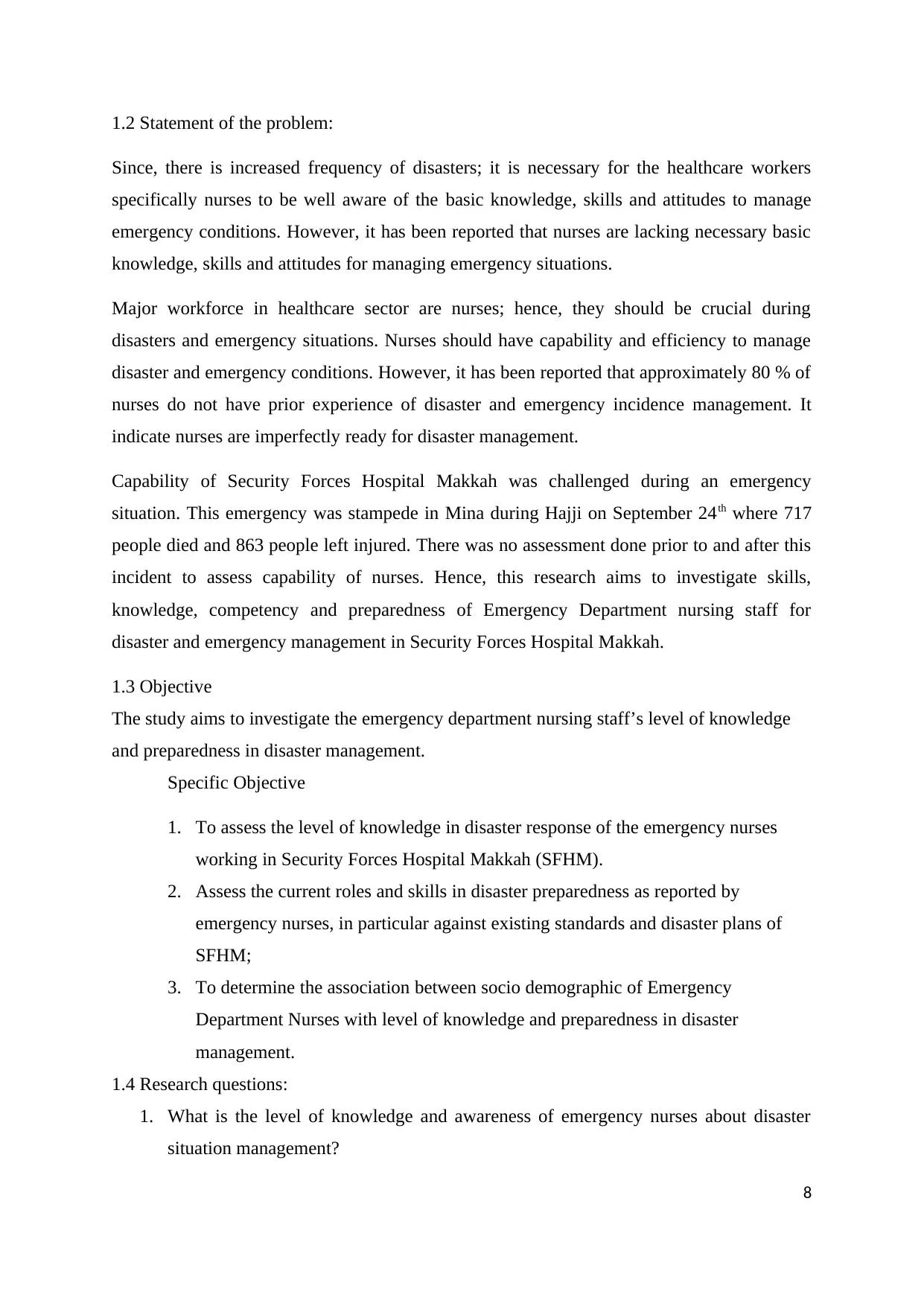
1.2 Statement of the problem:
Since, there is increased frequency of disasters; it is necessary for the healthcare workers
specifically nurses to be well aware of the basic knowledge, skills and attitudes to manage
emergency conditions. However, it has been reported that nurses are lacking necessary basic
knowledge, skills and attitudes for managing emergency situations.
Major workforce in healthcare sector are nurses; hence, they should be crucial during
disasters and emergency situations. Nurses should have capability and efficiency to manage
disaster and emergency conditions. However, it has been reported that approximately 80 % of
nurses do not have prior experience of disaster and emergency incidence management. It
indicate nurses are imperfectly ready for disaster management.
Capability of Security Forces Hospital Makkah was challenged during an emergency
situation. This emergency was stampede in Mina during Hajji on September 24th where 717
people died and 863 people left injured. There was no assessment done prior to and after this
incident to assess capability of nurses. Hence, this research aims to investigate skills,
knowledge, competency and preparedness of Emergency Department nursing staff for
disaster and emergency management in Security Forces Hospital Makkah.
1.3 Objective
The study aims to investigate the emergency department nursing staff’s level of knowledge
and preparedness in disaster management.
Specific Objective
1. To assess the level of knowledge in disaster response of the emergency nurses
working in Security Forces Hospital Makkah (SFHM).
2. Assess the current roles and skills in disaster preparedness as reported by
emergency nurses, in particular against existing standards and disaster plans of
SFHM;
3. To determine the association between socio demographic of Emergency
Department Nurses with level of knowledge and preparedness in disaster
management.
1.4 Research questions:
1. What is the level of knowledge and awareness of emergency nurses about disaster
situation management?
8
Since, there is increased frequency of disasters; it is necessary for the healthcare workers
specifically nurses to be well aware of the basic knowledge, skills and attitudes to manage
emergency conditions. However, it has been reported that nurses are lacking necessary basic
knowledge, skills and attitudes for managing emergency situations.
Major workforce in healthcare sector are nurses; hence, they should be crucial during
disasters and emergency situations. Nurses should have capability and efficiency to manage
disaster and emergency conditions. However, it has been reported that approximately 80 % of
nurses do not have prior experience of disaster and emergency incidence management. It
indicate nurses are imperfectly ready for disaster management.
Capability of Security Forces Hospital Makkah was challenged during an emergency
situation. This emergency was stampede in Mina during Hajji on September 24th where 717
people died and 863 people left injured. There was no assessment done prior to and after this
incident to assess capability of nurses. Hence, this research aims to investigate skills,
knowledge, competency and preparedness of Emergency Department nursing staff for
disaster and emergency management in Security Forces Hospital Makkah.
1.3 Objective
The study aims to investigate the emergency department nursing staff’s level of knowledge
and preparedness in disaster management.
Specific Objective
1. To assess the level of knowledge in disaster response of the emergency nurses
working in Security Forces Hospital Makkah (SFHM).
2. Assess the current roles and skills in disaster preparedness as reported by
emergency nurses, in particular against existing standards and disaster plans of
SFHM;
3. To determine the association between socio demographic of Emergency
Department Nurses with level of knowledge and preparedness in disaster
management.
1.4 Research questions:
1. What is the level of knowledge and awareness of emergency nurses about disaster
situation management?
8
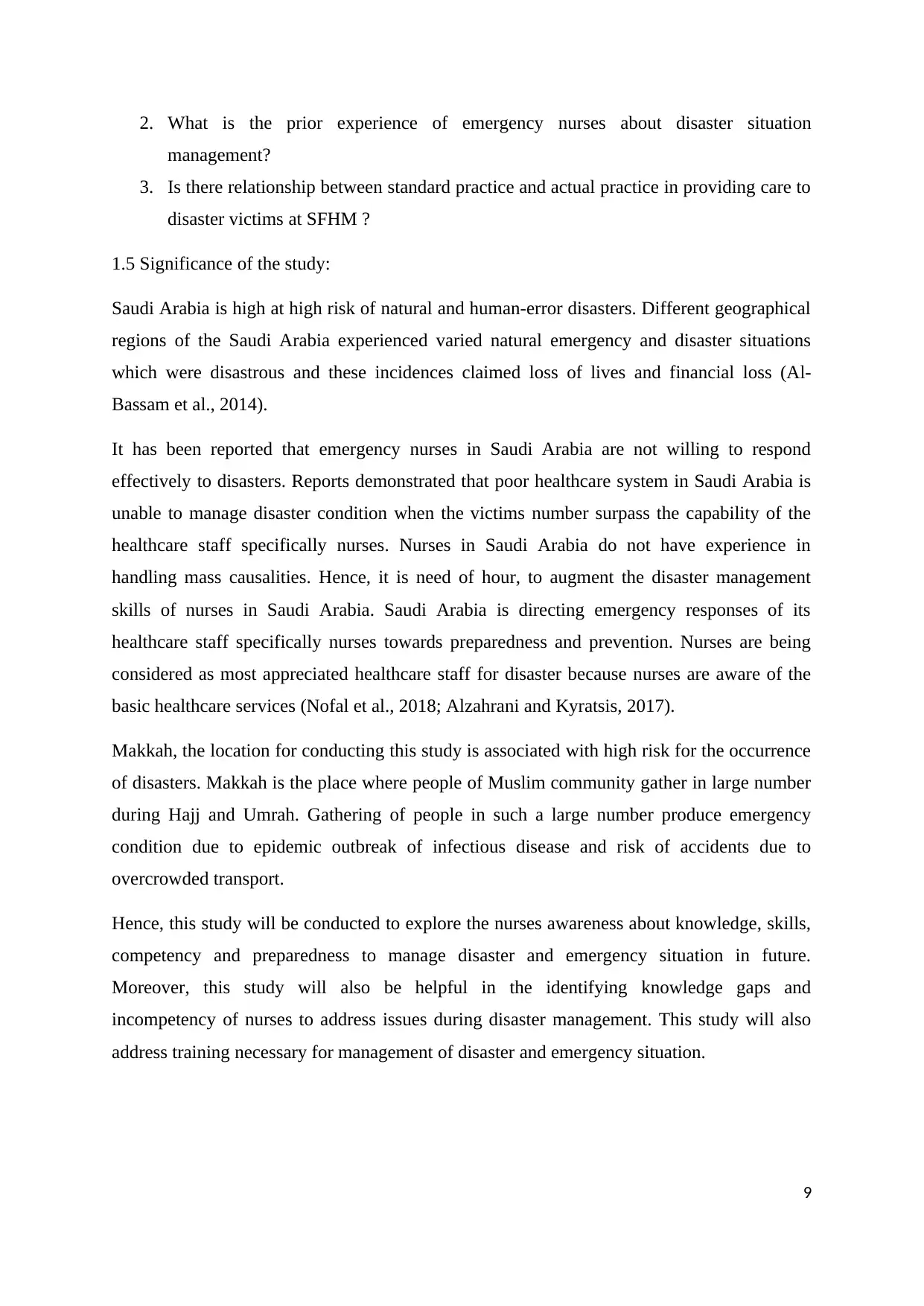
2. What is the prior experience of emergency nurses about disaster situation
management?
3. Is there relationship between standard practice and actual practice in providing care to
disaster victims at SFHM ?
1.5 Significance of the study:
Saudi Arabia is high at high risk of natural and human-error disasters. Different geographical
regions of the Saudi Arabia experienced varied natural emergency and disaster situations
which were disastrous and these incidences claimed loss of lives and financial loss (Al-
Bassam et al., 2014).
It has been reported that emergency nurses in Saudi Arabia are not willing to respond
effectively to disasters. Reports demonstrated that poor healthcare system in Saudi Arabia is
unable to manage disaster condition when the victims number surpass the capability of the
healthcare staff specifically nurses. Nurses in Saudi Arabia do not have experience in
handling mass causalities. Hence, it is need of hour, to augment the disaster management
skills of nurses in Saudi Arabia. Saudi Arabia is directing emergency responses of its
healthcare staff specifically nurses towards preparedness and prevention. Nurses are being
considered as most appreciated healthcare staff for disaster because nurses are aware of the
basic healthcare services (Nofal et al., 2018; Alzahrani and Kyratsis, 2017).
Makkah, the location for conducting this study is associated with high risk for the occurrence
of disasters. Makkah is the place where people of Muslim community gather in large number
during Hajj and Umrah. Gathering of people in such a large number produce emergency
condition due to epidemic outbreak of infectious disease and risk of accidents due to
overcrowded transport.
Hence, this study will be conducted to explore the nurses awareness about knowledge, skills,
competency and preparedness to manage disaster and emergency situation in future.
Moreover, this study will also be helpful in the identifying knowledge gaps and
incompetency of nurses to address issues during disaster management. This study will also
address training necessary for management of disaster and emergency situation.
9
management?
3. Is there relationship between standard practice and actual practice in providing care to
disaster victims at SFHM ?
1.5 Significance of the study:
Saudi Arabia is high at high risk of natural and human-error disasters. Different geographical
regions of the Saudi Arabia experienced varied natural emergency and disaster situations
which were disastrous and these incidences claimed loss of lives and financial loss (Al-
Bassam et al., 2014).
It has been reported that emergency nurses in Saudi Arabia are not willing to respond
effectively to disasters. Reports demonstrated that poor healthcare system in Saudi Arabia is
unable to manage disaster condition when the victims number surpass the capability of the
healthcare staff specifically nurses. Nurses in Saudi Arabia do not have experience in
handling mass causalities. Hence, it is need of hour, to augment the disaster management
skills of nurses in Saudi Arabia. Saudi Arabia is directing emergency responses of its
healthcare staff specifically nurses towards preparedness and prevention. Nurses are being
considered as most appreciated healthcare staff for disaster because nurses are aware of the
basic healthcare services (Nofal et al., 2018; Alzahrani and Kyratsis, 2017).
Makkah, the location for conducting this study is associated with high risk for the occurrence
of disasters. Makkah is the place where people of Muslim community gather in large number
during Hajj and Umrah. Gathering of people in such a large number produce emergency
condition due to epidemic outbreak of infectious disease and risk of accidents due to
overcrowded transport.
Hence, this study will be conducted to explore the nurses awareness about knowledge, skills,
competency and preparedness to manage disaster and emergency situation in future.
Moreover, this study will also be helpful in the identifying knowledge gaps and
incompetency of nurses to address issues during disaster management. This study will also
address training necessary for management of disaster and emergency situation.
9
⊘ This is a preview!⊘
Do you want full access?
Subscribe today to unlock all pages.

Trusted by 1+ million students worldwide
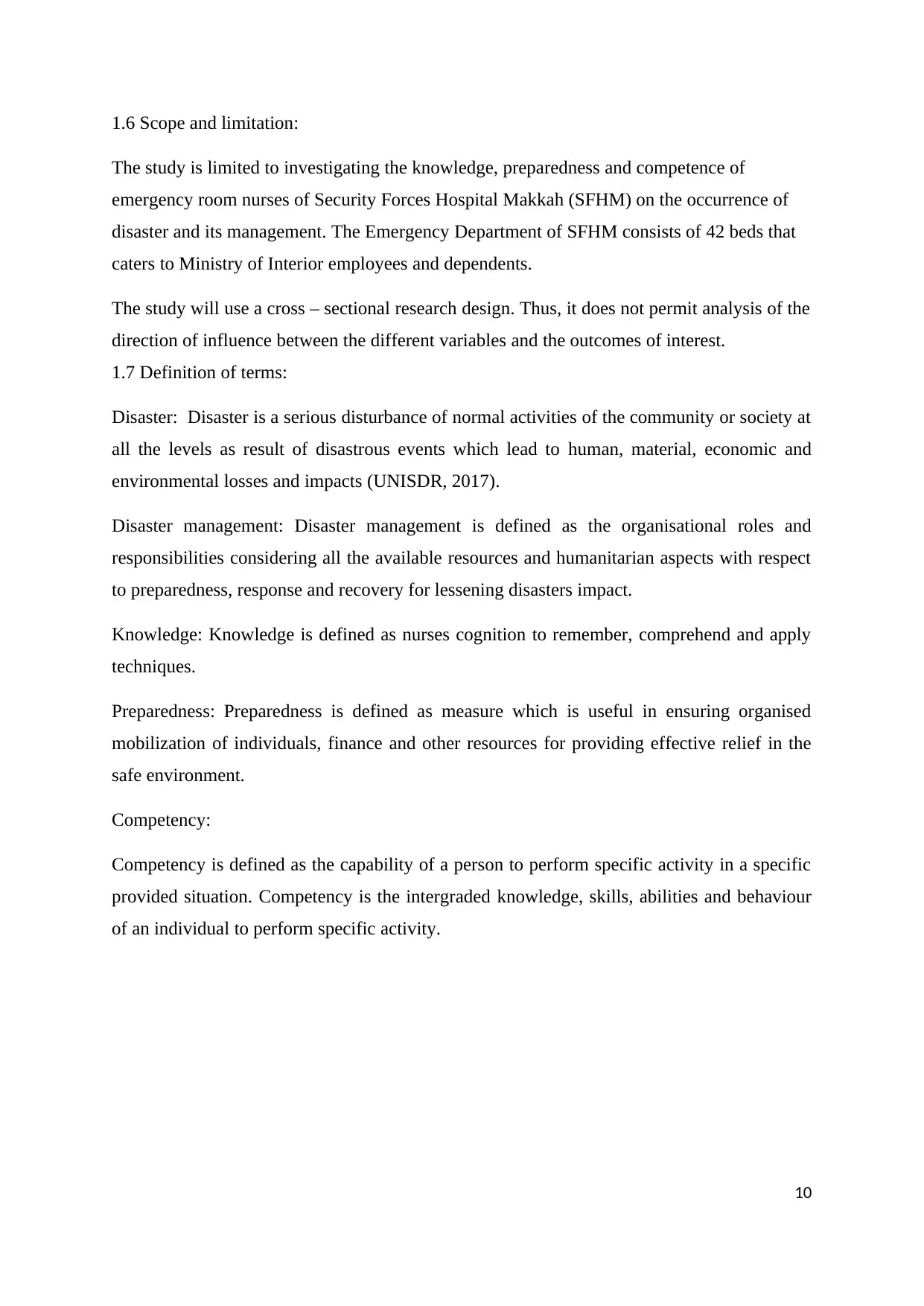
1.6 Scope and limitation:
The study is limited to investigating the knowledge, preparedness and competence of
emergency room nurses of Security Forces Hospital Makkah (SFHM) on the occurrence of
disaster and its management. The Emergency Department of SFHM consists of 42 beds that
caters to Ministry of Interior employees and dependents.
The study will use a cross – sectional research design. Thus, it does not permit analysis of the
direction of influence between the different variables and the outcomes of interest.
1.7 Definition of terms:
Disaster: Disaster is a serious disturbance of normal activities of the community or society at
all the levels as result of disastrous events which lead to human, material, economic and
environmental losses and impacts (UNISDR, 2017).
Disaster management: Disaster management is defined as the organisational roles and
responsibilities considering all the available resources and humanitarian aspects with respect
to preparedness, response and recovery for lessening disasters impact.
Knowledge: Knowledge is defined as nurses cognition to remember, comprehend and apply
techniques.
Preparedness: Preparedness is defined as measure which is useful in ensuring organised
mobilization of individuals, finance and other resources for providing effective relief in the
safe environment.
Competency:
Competency is defined as the capability of a person to perform specific activity in a specific
provided situation. Competency is the intergraded knowledge, skills, abilities and behaviour
of an individual to perform specific activity.
10
The study is limited to investigating the knowledge, preparedness and competence of
emergency room nurses of Security Forces Hospital Makkah (SFHM) on the occurrence of
disaster and its management. The Emergency Department of SFHM consists of 42 beds that
caters to Ministry of Interior employees and dependents.
The study will use a cross – sectional research design. Thus, it does not permit analysis of the
direction of influence between the different variables and the outcomes of interest.
1.7 Definition of terms:
Disaster: Disaster is a serious disturbance of normal activities of the community or society at
all the levels as result of disastrous events which lead to human, material, economic and
environmental losses and impacts (UNISDR, 2017).
Disaster management: Disaster management is defined as the organisational roles and
responsibilities considering all the available resources and humanitarian aspects with respect
to preparedness, response and recovery for lessening disasters impact.
Knowledge: Knowledge is defined as nurses cognition to remember, comprehend and apply
techniques.
Preparedness: Preparedness is defined as measure which is useful in ensuring organised
mobilization of individuals, finance and other resources for providing effective relief in the
safe environment.
Competency:
Competency is defined as the capability of a person to perform specific activity in a specific
provided situation. Competency is the intergraded knowledge, skills, abilities and behaviour
of an individual to perform specific activity.
10
Paraphrase This Document
Need a fresh take? Get an instant paraphrase of this document with our AI Paraphraser
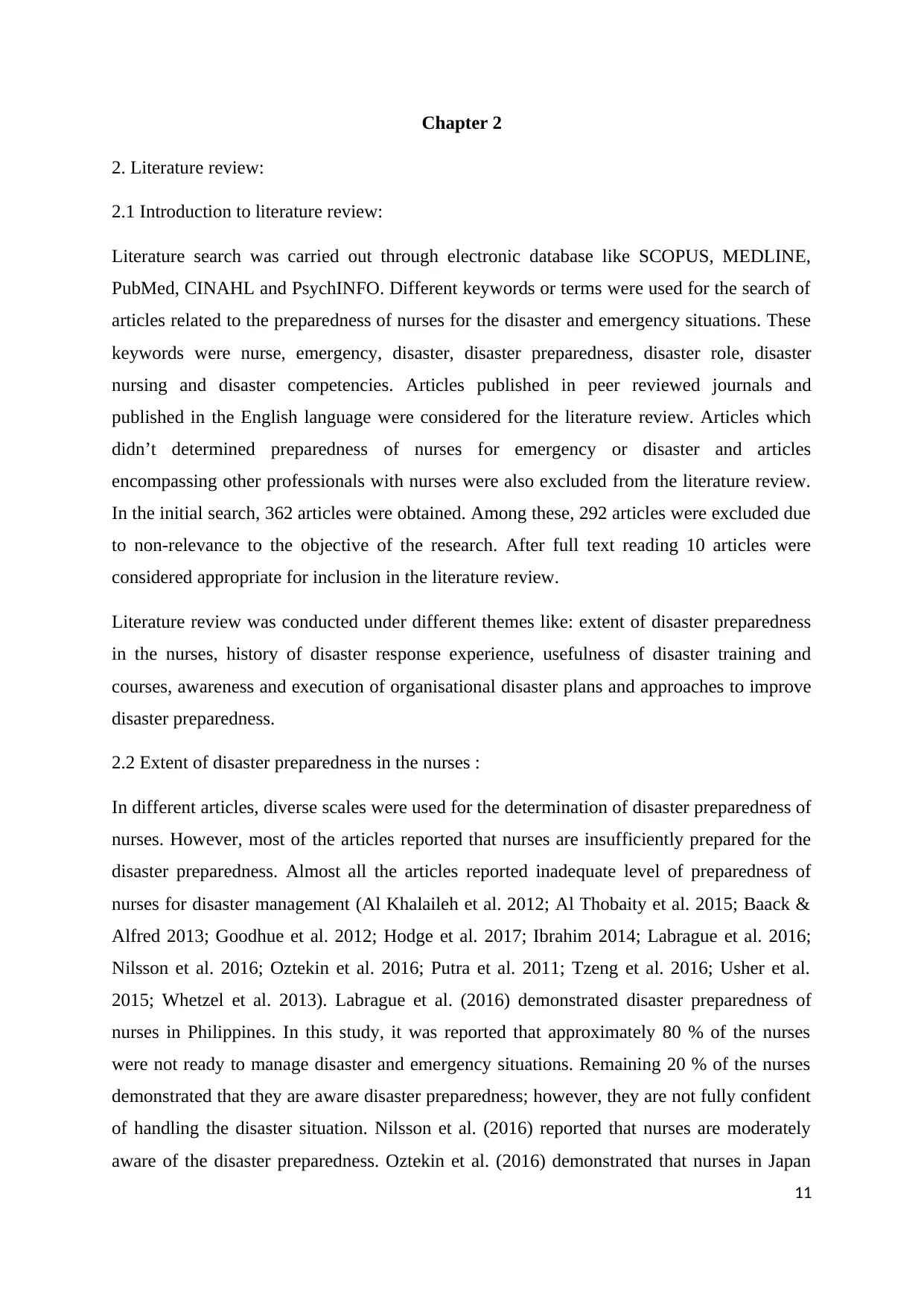
Chapter 2
2. Literature review:
2.1 Introduction to literature review:
Literature search was carried out through electronic database like SCOPUS, MEDLINE,
PubMed, CINAHL and PsychINFO. Different keywords or terms were used for the search of
articles related to the preparedness of nurses for the disaster and emergency situations. These
keywords were nurse, emergency, disaster, disaster preparedness, disaster role, disaster
nursing and disaster competencies. Articles published in peer reviewed journals and
published in the English language were considered for the literature review. Articles which
didn’t determined preparedness of nurses for emergency or disaster and articles
encompassing other professionals with nurses were also excluded from the literature review.
In the initial search, 362 articles were obtained. Among these, 292 articles were excluded due
to non-relevance to the objective of the research. After full text reading 10 articles were
considered appropriate for inclusion in the literature review.
Literature review was conducted under different themes like: extent of disaster preparedness
in the nurses, history of disaster response experience, usefulness of disaster training and
courses, awareness and execution of organisational disaster plans and approaches to improve
disaster preparedness.
2.2 Extent of disaster preparedness in the nurses :
In different articles, diverse scales were used for the determination of disaster preparedness of
nurses. However, most of the articles reported that nurses are insufficiently prepared for the
disaster preparedness. Almost all the articles reported inadequate level of preparedness of
nurses for disaster management (Al Khalaileh et al. 2012; Al Thobaity et al. 2015; Baack &
Alfred 2013; Goodhue et al. 2012; Hodge et al. 2017; Ibrahim 2014; Labrague et al. 2016;
Nilsson et al. 2016; Oztekin et al. 2016; Putra et al. 2011; Tzeng et al. 2016; Usher et al.
2015; Whetzel et al. 2013). Labrague et al. (2016) demonstrated disaster preparedness of
nurses in Philippines. In this study, it was reported that approximately 80 % of the nurses
were not ready to manage disaster and emergency situations. Remaining 20 % of the nurses
demonstrated that they are aware disaster preparedness; however, they are not fully confident
of handling the disaster situation. Nilsson et al. (2016) reported that nurses are moderately
aware of the disaster preparedness. Oztekin et al. (2016) demonstrated that nurses in Japan
11
2. Literature review:
2.1 Introduction to literature review:
Literature search was carried out through electronic database like SCOPUS, MEDLINE,
PubMed, CINAHL and PsychINFO. Different keywords or terms were used for the search of
articles related to the preparedness of nurses for the disaster and emergency situations. These
keywords were nurse, emergency, disaster, disaster preparedness, disaster role, disaster
nursing and disaster competencies. Articles published in peer reviewed journals and
published in the English language were considered for the literature review. Articles which
didn’t determined preparedness of nurses for emergency or disaster and articles
encompassing other professionals with nurses were also excluded from the literature review.
In the initial search, 362 articles were obtained. Among these, 292 articles were excluded due
to non-relevance to the objective of the research. After full text reading 10 articles were
considered appropriate for inclusion in the literature review.
Literature review was conducted under different themes like: extent of disaster preparedness
in the nurses, history of disaster response experience, usefulness of disaster training and
courses, awareness and execution of organisational disaster plans and approaches to improve
disaster preparedness.
2.2 Extent of disaster preparedness in the nurses :
In different articles, diverse scales were used for the determination of disaster preparedness of
nurses. However, most of the articles reported that nurses are insufficiently prepared for the
disaster preparedness. Almost all the articles reported inadequate level of preparedness of
nurses for disaster management (Al Khalaileh et al. 2012; Al Thobaity et al. 2015; Baack &
Alfred 2013; Goodhue et al. 2012; Hodge et al. 2017; Ibrahim 2014; Labrague et al. 2016;
Nilsson et al. 2016; Oztekin et al. 2016; Putra et al. 2011; Tzeng et al. 2016; Usher et al.
2015; Whetzel et al. 2013). Labrague et al. (2016) demonstrated disaster preparedness of
nurses in Philippines. In this study, it was reported that approximately 80 % of the nurses
were not ready to manage disaster and emergency situations. Remaining 20 % of the nurses
demonstrated that they are aware disaster preparedness; however, they are not fully confident
of handling the disaster situation. Nilsson et al. (2016) reported that nurses are moderately
aware of the disaster preparedness. Oztekin et al. (2016) demonstrated that nurses in Japan
11
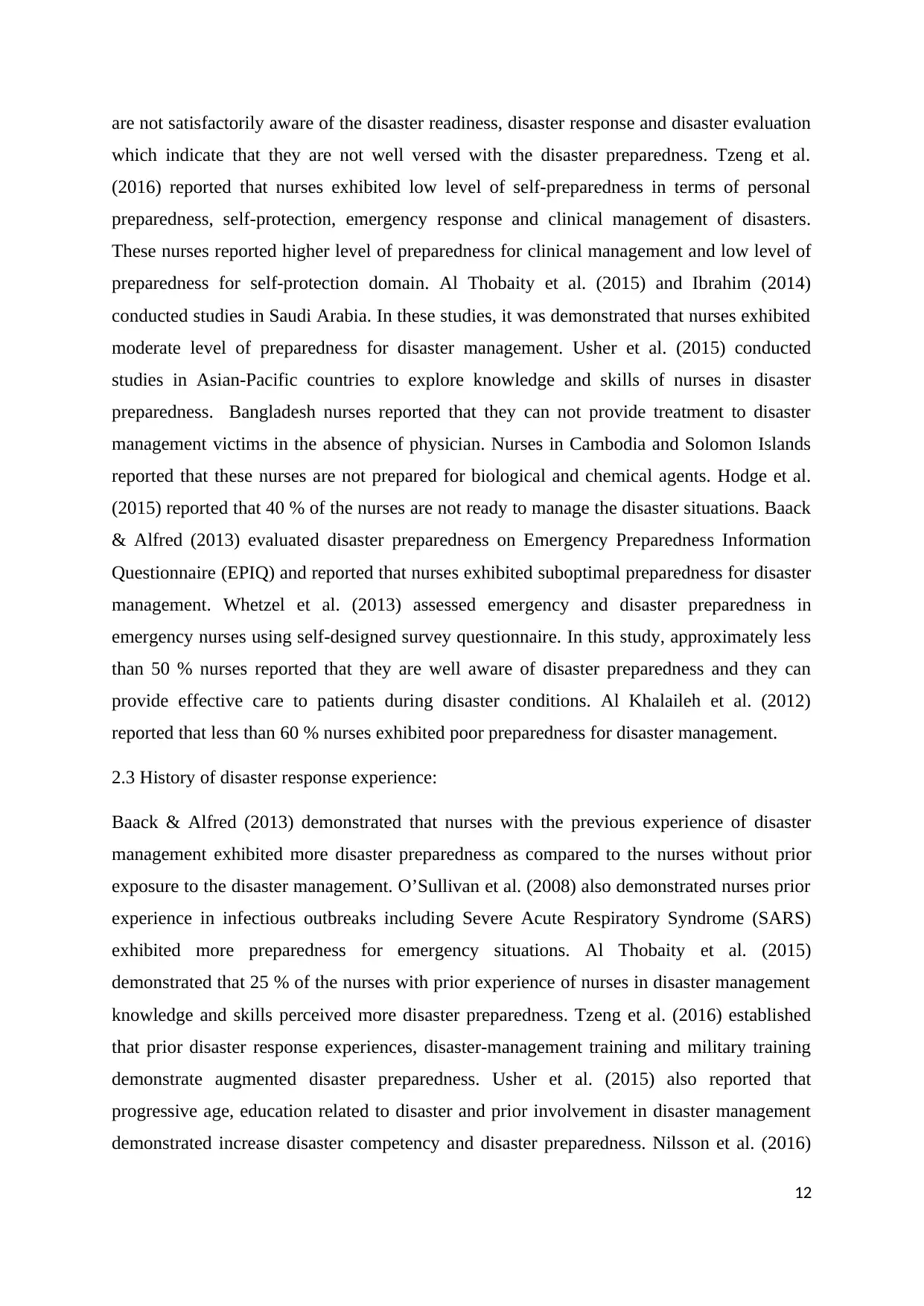
are not satisfactorily aware of the disaster readiness, disaster response and disaster evaluation
which indicate that they are not well versed with the disaster preparedness. Tzeng et al.
(2016) reported that nurses exhibited low level of self-preparedness in terms of personal
preparedness, self-protection, emergency response and clinical management of disasters.
These nurses reported higher level of preparedness for clinical management and low level of
preparedness for self-protection domain. Al Thobaity et al. (2015) and Ibrahim (2014)
conducted studies in Saudi Arabia. In these studies, it was demonstrated that nurses exhibited
moderate level of preparedness for disaster management. Usher et al. (2015) conducted
studies in Asian-Pacific countries to explore knowledge and skills of nurses in disaster
preparedness. Bangladesh nurses reported that they can not provide treatment to disaster
management victims in the absence of physician. Nurses in Cambodia and Solomon Islands
reported that these nurses are not prepared for biological and chemical agents. Hodge et al.
(2015) reported that 40 % of the nurses are not ready to manage the disaster situations. Baack
& Alfred (2013) evaluated disaster preparedness on Emergency Preparedness Information
Questionnaire (EPIQ) and reported that nurses exhibited suboptimal preparedness for disaster
management. Whetzel et al. (2013) assessed emergency and disaster preparedness in
emergency nurses using self-designed survey questionnaire. In this study, approximately less
than 50 % nurses reported that they are well aware of disaster preparedness and they can
provide effective care to patients during disaster conditions. Al Khalaileh et al. (2012)
reported that less than 60 % nurses exhibited poor preparedness for disaster management.
2.3 History of disaster response experience:
Baack & Alfred (2013) demonstrated that nurses with the previous experience of disaster
management exhibited more disaster preparedness as compared to the nurses without prior
exposure to the disaster management. O’Sullivan et al. (2008) also demonstrated nurses prior
experience in infectious outbreaks including Severe Acute Respiratory Syndrome (SARS)
exhibited more preparedness for emergency situations. Al Thobaity et al. (2015)
demonstrated that 25 % of the nurses with prior experience of nurses in disaster management
knowledge and skills perceived more disaster preparedness. Tzeng et al. (2016) established
that prior disaster response experiences, disaster-management training and military training
demonstrate augmented disaster preparedness. Usher et al. (2015) also reported that
progressive age, education related to disaster and prior involvement in disaster management
demonstrated increase disaster competency and disaster preparedness. Nilsson et al. (2016)
12
which indicate that they are not well versed with the disaster preparedness. Tzeng et al.
(2016) reported that nurses exhibited low level of self-preparedness in terms of personal
preparedness, self-protection, emergency response and clinical management of disasters.
These nurses reported higher level of preparedness for clinical management and low level of
preparedness for self-protection domain. Al Thobaity et al. (2015) and Ibrahim (2014)
conducted studies in Saudi Arabia. In these studies, it was demonstrated that nurses exhibited
moderate level of preparedness for disaster management. Usher et al. (2015) conducted
studies in Asian-Pacific countries to explore knowledge and skills of nurses in disaster
preparedness. Bangladesh nurses reported that they can not provide treatment to disaster
management victims in the absence of physician. Nurses in Cambodia and Solomon Islands
reported that these nurses are not prepared for biological and chemical agents. Hodge et al.
(2015) reported that 40 % of the nurses are not ready to manage the disaster situations. Baack
& Alfred (2013) evaluated disaster preparedness on Emergency Preparedness Information
Questionnaire (EPIQ) and reported that nurses exhibited suboptimal preparedness for disaster
management. Whetzel et al. (2013) assessed emergency and disaster preparedness in
emergency nurses using self-designed survey questionnaire. In this study, approximately less
than 50 % nurses reported that they are well aware of disaster preparedness and they can
provide effective care to patients during disaster conditions. Al Khalaileh et al. (2012)
reported that less than 60 % nurses exhibited poor preparedness for disaster management.
2.3 History of disaster response experience:
Baack & Alfred (2013) demonstrated that nurses with the previous experience of disaster
management exhibited more disaster preparedness as compared to the nurses without prior
exposure to the disaster management. O’Sullivan et al. (2008) also demonstrated nurses prior
experience in infectious outbreaks including Severe Acute Respiratory Syndrome (SARS)
exhibited more preparedness for emergency situations. Al Thobaity et al. (2015)
demonstrated that 25 % of the nurses with prior experience of nurses in disaster management
knowledge and skills perceived more disaster preparedness. Tzeng et al. (2016) established
that prior disaster response experiences, disaster-management training and military training
demonstrate augmented disaster preparedness. Usher et al. (2015) also reported that
progressive age, education related to disaster and prior involvement in disaster management
demonstrated increase disaster competency and disaster preparedness. Nilsson et al. (2016)
12
⊘ This is a preview!⊘
Do you want full access?
Subscribe today to unlock all pages.

Trusted by 1+ million students worldwide
1 out of 40
Related Documents
Your All-in-One AI-Powered Toolkit for Academic Success.
+13062052269
info@desklib.com
Available 24*7 on WhatsApp / Email
![[object Object]](/_next/static/media/star-bottom.7253800d.svg)
Unlock your academic potential
Copyright © 2020–2025 A2Z Services. All Rights Reserved. Developed and managed by ZUCOL.





